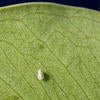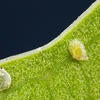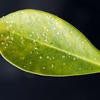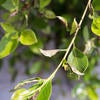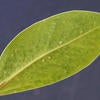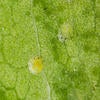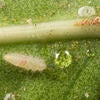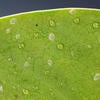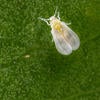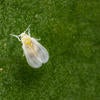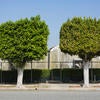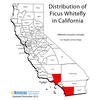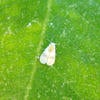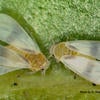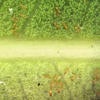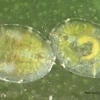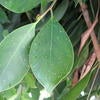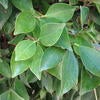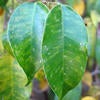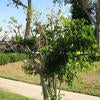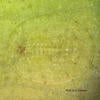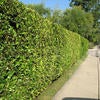Ficus Whitefly (Singhiella simplex) (Fig Whitefly)
Hosts and damage: Attacks various Ficus species (F. aurea, F. altissima, F. bengalensis, F. benjamina,
F. lyrata, F. microcarpa, and F. maclellandii). Was also observed on Rhododendron (Azalea) indica. Feeding may cause yellowing of leaves, defoliation and branch dieback. High populations are able to stunt the growth of young trees. S. simplex populations may reproduce rapidly and emerging adult numbers may be quite large. In some cities of Los Angeles County where Ficus trees were commonly planted on sidewalks and street medians, clouds of adult Ficus whiteflies were observed creating a nuisance for residents
Identification: Adults (about 1.4-1.6 mm) have white wings with faint grayish-brown markings. Eyes dark red.
Fly readily when disturbed. Nymphs have light green to tan, often semitransparent, oval bodies which may blend with the surrounding leaf surface. Pupae with red eyes. Unlike many other whitefly species, immature stages of S. simplex can be found on both lower and upper surfaces of leaves. Ficus Whitefly eggs are yellow to light brown color, elongate. Deposited mostly along the midvein on the underside of the leaves.
Distribution: Native to southeastern Asia (Myanmar, China and India). Introduced into the U.S.: Florida (2007) and California (2012). Ficus Whitefly was also introduced into Brasil in 2009.
More Media on the Ficus Whitefly
Slideshare.net: Ficus Whitefly (Portuguese)
UF/IFAS Tropical Research and Education Center: Ficus Whitefly and Other Pests of Ficus
UF/IFAS Tropical Research and Education Center: Ficus Whitefly
University of Florida: Ficus Whitefly Management in the Landscape
University of Florida: Got Dying Ficus?
Center for Invasive Species Research, University of California, Riverside
Text and photos provided by: Gevork Arakelian
Gevork Arakelian, Senior Biologist, Los Angeles County Agricultural Commissioner/Weights & Measures Department.
GArakelian@acwm.lacounty.gov
Media within CISR is licensed under a Creative Commons Attribution-NonCommercial-NoDerivs 3.0 Unported License. Permissions beyond this scope may be available at www.cisr.ucr.edu/media-usage.
